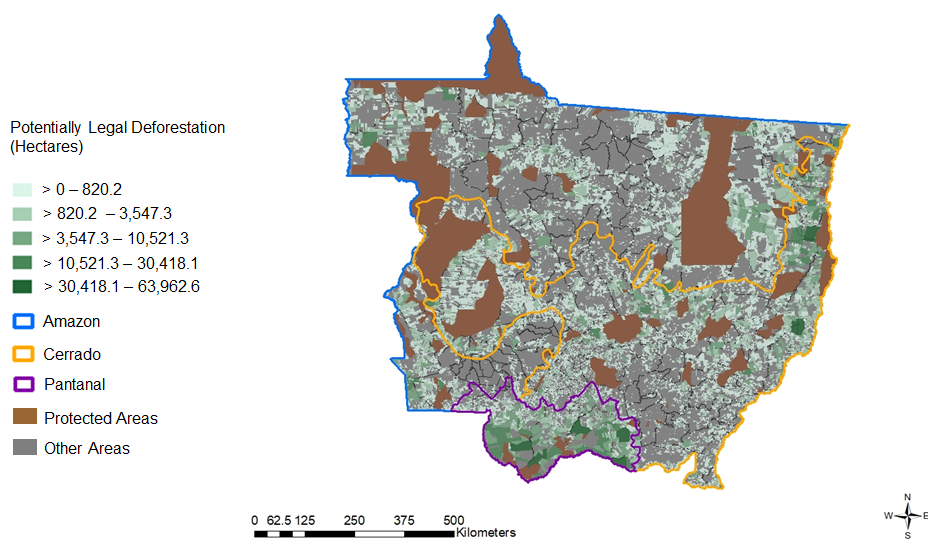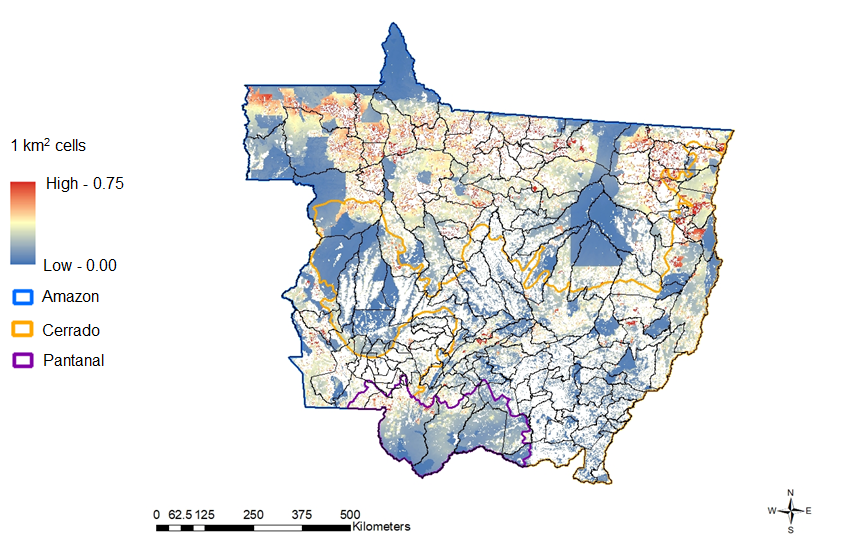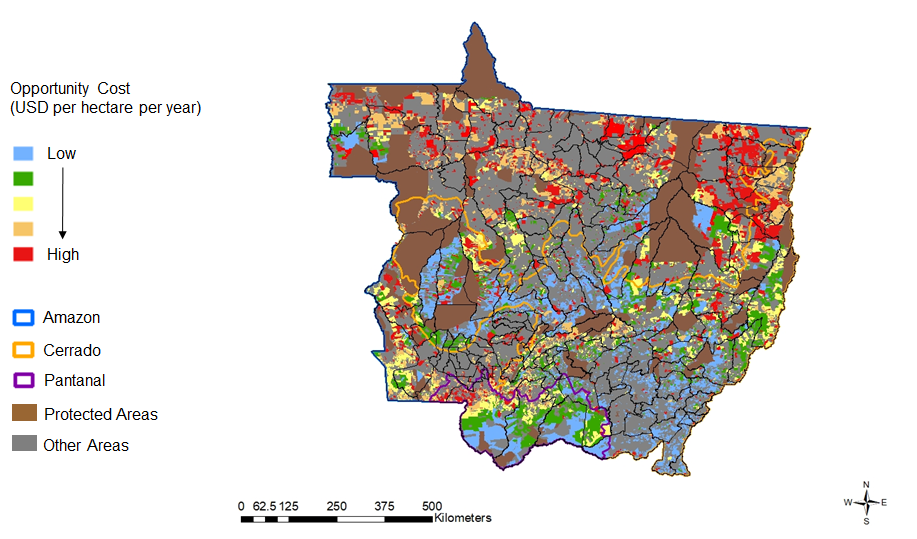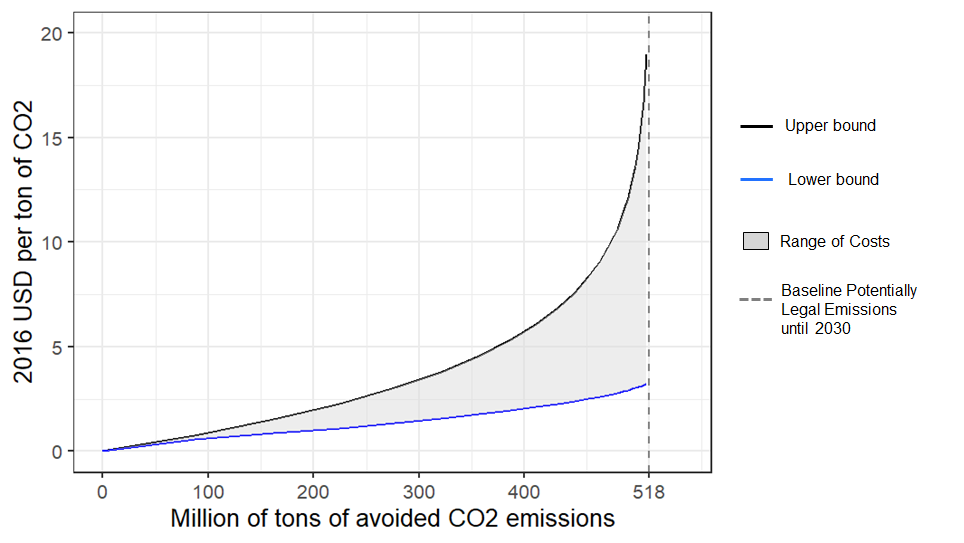Join us during London Climate Action Week for the webinar Demonstrating on-the-ground incentives to protect forests in Mato Grosso, Brazil on November 16th, 11:30 am EST where we’ll be discussing this issue and more. Watch the recording here.
By Breno Pietracci, Ph.D., economist at Environmental Defense Fund
Many Brazilian farmers have large tracts of Amazon rainforest and Cerrado tropical savanna on their properties. According to the 2012 Brazilian Forest Code, landowners in the Amazon must maintain at least 80% of their farms as standing forests while those in the Cerrado must keep no less than 35%. Farmers have the right to clear all vegetation above these legal thresholds.
But what if over-compliant farmers were financially rewarded to keep those forests they can legally deforest alive? That’s the aim of CONSERV, a novel and groundbreaking forest protection program recently launched in Brazil, with international debut scheduled for the London Climate Action Week. CONSERV is a systemic, scalable initiative that constitutes part of a set of strategies that can reduce deforestation at a jurisdictional (national or state-level) scale.
Brazil has successfully reduced deforestation by deploying an arsenal of command-and-control forest conservation policies over the last decades. From 2004 to 2012, deforestation in the Legal Amazon fell by more than 80% with a combination of increased law enforcement, expansion of protected areas – indigenous territories and conservation units, rural credit reforms and supply chain initiatives. Such remarkable achievement has mainly relied upon using “sticks” (penalties) and only limited “carrots” (incentives).
Over those years, some multilateral programs have attempted to use incentive-based payments for performance in reducing deforestation at large scales, namely the Amazon Fund and the REDD+ Early Movers program in the states of Acre and Mato Grosso. However, these have not yet been deployed at a scale to significantly change the behavior of rural producers.
As few positive incentives have materialized in the effort to reduce Amazon deforestation in Brazil, since 2013 the gains in preventing deforestation have stalled and are now under threat with weakened command-and-control and law enforcement. CONSERV is a first step in providing the missing positive incentive piece of the equation.
What makes CONSERV different?
CONSERV innovates and adds to the forest protection toolbox by being the first private and voluntary mechanism targeted at a previously unattended goal; avoiding legal deforestation on a large scale by changing farmers’ incentives towards preservation. The Amazon Environmental Research Institute, or IPAM, estimates that even if illegal deforestation could be halted, an area of more than 20 million hectares of native forest can potentially be legally cleared in the Brazilian Legal Amazon. That is almost an area of the size of the United Kingdom.
CONSERV was designed by IPAM, along with EDF and Woodwell Climate Research Center. The pilot phase of the program will finance forest protection inside rural private properties in the agricultural powerhouse state of Mato Grosso, where large sections of the Amazon rainforest and the Cerrado savanna are located.
Mato Grosso hosts more than seven million hectares of forestland on rural private properties that can be potentially lawfully cleared with the appropriate government permits, as portrayed in Figure 1. This is an area equivalent to Ireland or the US state of West Virginia. It holds an estimated carbon stock of around 2.4 Gt CO2e. If emitted at once, this would exceed the 2016 emissions of all countries but China (11.6 Gt CO2e), the US (5.8 Gt CO2e) and India (3.2 Gt CO2e). In comparison, Brazil emitted 1.4 Gt CO2e in 2016.¹

Figure 1. Areas Available for Potentially Legal Conversion by Property in 2017 (hectares). Source: IPAM – Amazon Environmental Research Institute.
How does it work?
CONSERV will pay enrolled farmers who hold forestlands above and beyond legal requirements on their properties, conditional on continued preservation. The program is targeting payments at regions that have been estimated to provide the greatest “bang for the buck” in terms of environmental benefits per funds spent and will rigorously evaluate the impacts of the payments on deforestation and socioeconomic outcomes.
The pilot phase of the program kick-started with seven farmers who signed 30-month contracts to shield 6,500 at-risk forest hectares (about 16,000 acres) in the municipality of Sapezal, a major soybean producer; payment disbursements will be issued twice a year. Next, the pilot program will expand to enroll more farmers in two other municipalities vetted by extensive economic and environmental analyses, field visits, surveys and stakeholder engagement conducted by IPAM, EDF and Woodwell, to protect at least 20,000 hectares of forestland in total (about 50,000 acres).
CONSERV has received initial funding from the governments of Norway and the Netherlands and is developing plans for scaling up with both public and private funding. The video below details how CONSERV works:
To help set up CONSERV, EDF developed an econometric model to estimate the effect of land prices on deforestation. The model used fine resolution spatial data, while controlling for other factors that affect the profitability of land conversion, such as accessibility to roads and terrain features.
The model enabled researchers to:
- Categorize areas under high deforestation threat through 2030 as portrayed in Figure 2;
- Approximate farmers’ opportunity costs – the potential foregone profits from not converting forests to agriculture. It provides a yardstick of how much each farmer would ask to voluntarily join the program, i.e. their willingness to accept to waive their rights to legally deforest their properties depicted in Figure 3; and
- Build marginal CO2e abatement cost curves displayed in Figure 4, allowing us to compare CONSERV with the costs of alternative climate change mitigation strategies.

Figure 2. Forecasted Potentially Legal and Illegal Deforestation in Mato Grosso by 2030 (1 km2 grid cells). Source: Environmental Defense Fund.
Distinguishing between hectares at-risk of deforestation, and those that are not, and assessing farmers’ opportunity costs from preserving forests that could be legally deforested are both crucial to effectively targeting payments and maximizing environmental benefits and minimizing costs.

Figure 3. Farmers’ Estimated Opportunity Costs of Forest Conservation trough 2030 (USD/hectare/year). Source: Environmental Defense Fund.
Finally, the analysis has shown that while significant conservation gains can be made through eliminating illegal deforestation, novel incentive policies such as CONSERV can be used to protect forestland that can be legally deforested on private properties, whilst giving agricultural producers another income source.
What’s next?
First, the research team will perform a rigorous analysis to evaluate the impacts of the pilot program on deforestation.
Moving forward, CONSERV will seek to gain jurisdictional scale – state and national. By leveraging private and public finance, we have analyzed how the program could potentially protect at least one million hectares of at-risk forestland in private farms that could be legally deforested by 2030, aligned with the goals of Mato Grosso’s jurisdictional strategy Produce, Conserve and Include (PCI).
According to the marginal abatement cost curve shown in Figure 4, which we derived from our opportunity cost analysis, protecting one million hectares of forestland would avoid estimated emissions of 387 million tons of CO2e at a price ranging from 1.96 (blue line) to 5.32 (black line) USD per ton, depending on the how the program targets payments to farmers and its duration. Those figures position CONSERV as a low-cost climate mitigation option, alongside with law enforcement and a broader package of strategies aligned with the PCI.

Figure 4. CO2e Marginal Abatement Cost Curve for Potentially Legal Deforestation by 2030. Source: Environmental Defense Fund.
Get Involved
- For more information, please visit the CONSERV program website: https://conserv.org.br/
- To attend the London Climate Action Week webinar on CONSERV please visit:
“Demonstrating on-the-ground incentives to protect forests in Mato Grosso, Brazil”.
November 16th, 2020 at 11:30 am – 1 pm EST (1:30 pm – 3 pm BSB) - To learn more about opportunities for corporate engagement in CONSERV, please visit our EDF+Biz blog titled “Is focusing on forests the answer for companies racing to meet climate goals?”.
¹ Source: https://www.climatewatchdata.org/










